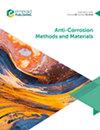Studies of zinc content reduction using flake zinc powder in epoxy zinc-rich coatings
IF 2.6
4区 材料科学
Q2 METALLURGY & METALLURGICAL ENGINEERING
引用次数: 0
Abstract
Purpose Epoxy zinc-rich coatings are widely used in harsh environments because of the long-lasting cathodic protection of steel surfaces. The purpose of this paper is to use flake zinc powder instead of the commonly used spherical zinc powder to reduce the zinc powder content. Design/methodology/approach In this paper, the authors have prepared an anticorrosive zinc-rich coating using a flake zinc powder instead of the conventional spherical zinc powder. The optimal dispersion of scaly zinc powder in zinc-rich coatings has been explored by looking at the surface and cross-sectional morphology and studying the cathodic protection time of the coating. Findings The final epoxy zinc-rich coating with 35 Wt.% flake zinc powder content was prepared using sand-milling dispersions. It has a similar cathodic protection time and salt spray resistance as the 60 Wt.% spherical zinc-rich coating, with a higher low-frequency impedance modulus value. Originality/value This study uses flake zinc powder instead of the traditional spherical zinc powder. This reduces the amount of zinc powder in the coating and improves the corrosion resistance of the coating.片状锌粉在环氧富锌涂料中的降锌研究
目的环氧富锌涂料由于对钢表面具有持久的阴极保护作用,在恶劣环境中得到广泛应用。本文的目的是用片状锌粉代替常用的球形锌粉,以降低锌粉含量。设计/方法/方法本文采用片状锌粉代替传统的球形锌粉制备了一种防腐富锌涂料。通过对富锌涂层表面形貌和横截面形貌的观察,以及镀层阴极保护时间的研究,探索了鳞状锌粉在富锌涂层中的最佳分散方式。结果采用砂磨分散体制备了片状锌含量为35 Wt.%的环氧富锌涂料。具有与60wt .%球形富锌涂层相近的阴极保护时间和耐盐雾性能,具有较高的低频阻抗模量值。本研究采用片状锌粉代替传统的球形锌粉。这样可以减少涂层中锌粉的含量,提高涂层的耐腐蚀性。
本文章由计算机程序翻译,如有差异,请以英文原文为准。
求助全文
约1分钟内获得全文
求助全文
来源期刊

Anti-corrosion Methods and Materials
工程技术-冶金工程
CiteScore
2.80
自引率
16.70%
发文量
61
审稿时长
13.5 months
期刊介绍:
Anti-Corrosion Methods and Materials publishes a broad coverage of the materials and techniques employed in corrosion prevention. Coverage is essentially of a practical nature and designed to be of material benefit to those working in the field. Proven applications are covered together with company news and new product information. Anti-Corrosion Methods and Materials now also includes research articles that reflect the most interesting and strategically important research and development activities from around the world.
Every year, industry pays a massive and rising cost for its corrosion problems. Research and development into new materials, processes and initiatives to combat this loss is increasing, and new findings are constantly coming to light which can help to beat corrosion problems throughout industry. This journal uniquely focuses on these exciting developments to make essential reading for anyone aiming to regain profits lost through corrosion difficulties.
• New methods, materials and software
• New developments in research and industry
• Stainless steels
• Protection of structural steelwork
• Industry update, conference news, dates and events
• Environmental issues
• Health & safety, including EC regulations
• Corrosion monitoring and plant health assessment
• The latest equipment and processes
• Corrosion cost and corrosion risk management.
 求助内容:
求助内容: 应助结果提醒方式:
应助结果提醒方式:


